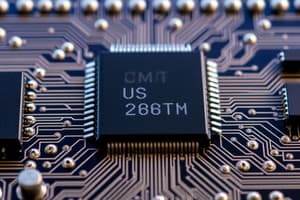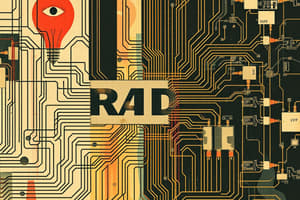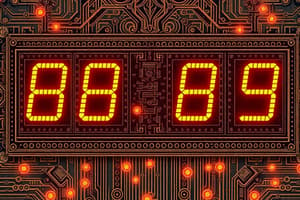Podcast
Questions and Answers
What distinguishes sequential circuits from combinational circuits?
What distinguishes sequential circuits from combinational circuits?
- Sequential circuits have a simpler design than combinational circuits.
- Sequential circuits can change output based on both current inputs and previous states. (correct)
- Sequential circuits only consider the current inputs.
- Sequential circuits operate independently of the input signals.
Which of the following statements accurately describes synchronous sequential circuits?
Which of the following statements accurately describes synchronous sequential circuits?
- They have no dependency on timing for their operation.
- They can operate asynchronously with input changes.
- They require a clock pulse for state transitions. (correct)
- They change state regardless of input.
What is a key characteristic of asynchronous sequential circuits?
What is a key characteristic of asynchronous sequential circuits?
- They require more complex circuitry than synchronous circuits.
- They are generally slower than synchronous circuits.
- They can transition states at any time with input changes. (correct)
- They only respond to clock signals.
How are sequential switching circuits classified?
How are sequential switching circuits classified?
What defines the logic of a circuit?
What defines the logic of a circuit?
Which of the following advantages is attributed to digital systems over analog systems?
Which of the following advantages is attributed to digital systems over analog systems?
What constitutes a hybrid system?
What constitutes a hybrid system?
In which stage of digital system design is the interconnection of logic building blocks determined?
In which stage of digital system design is the interconnection of logic building blocks determined?
Which statement best describes circuit design?
Which statement best describes circuit design?
What does a positive logic system indicate regarding voltage levels?
What does a positive logic system indicate regarding voltage levels?
Flashcards
Sequential Circuit
Sequential Circuit
A circuit where the output depends on both the current input and the previous input(s) or circuit state.
Synchronous Sequential Circuit
Synchronous Sequential Circuit
A sequential circuit where state changes only happen with a clock pulse.
Asynchronous Sequential Circuit
Asynchronous Sequential Circuit
A sequential circuit where state changes can happen immediately when inputs change.
Logic Circuit
Logic Circuit
Signup and view all the flashcards
Circuit's Logic
Circuit's Logic
Signup and view all the flashcards
Digital System Advantages
Digital System Advantages
Signup and view all the flashcards
Digital System Limitation
Digital System Limitation
Signup and view all the flashcards
System Design
System Design
Signup and view all the flashcards
Logic Design
Logic Design
Signup and view all the flashcards
Circuit Design
Circuit Design
Signup and view all the flashcards
Study Notes
Sequential Circuits
- Switching circuits whose output depends on present inputs and past history are sequential circuits
- Synchronous sequential circuits have state transitions triggered by a clock pulse
- Asynchronous sequential circuits have state transitions triggered whenever input changes
Classification of Sequential Switching Circuits
- Classified as synchronous and asynchronous
- Synchronous circuits have state transitions occur on clock pulses
- Asynchronous circuits have state transitions triggered by input changes at any time
Logic Circuits
- Digital circuits follow a set of logic rules
- Circuit's logic refers to how the circuit responds to inputs
Advantages of Digital Systems
- More versatile
- Easier to store data
- Easier to design
- Less affected by noise
- More accurate and precise than analog systems
Limitation of Digital Systems
- "Real world is not digital, it is analog"
Hybrid Systems
- Combine analog and digital techniques in a single system
Digital System Design Stages
- System design
- Logic design
- Circuit design
System Design
- Breaks down the overall system into subsystems
- Defines characteristics of each subsystem
- Specifies interconnections and control of subsystems
- Example: Digital computer system design—specifies memory, arithmetic units, and input/output devices
Logic Design
- Determines how to interconnect logic building blocks to perform a specific function
- Example: Logic design for binary addition—determines interconnection of logic gates and flip-flops
Circuit Design
- Specifies interconnection of components (e.g., resistors, transistors, diodes) to form logical blocks (e.g., gates, flip-flops)
Positive Logic System
- Higher voltage level represents logic 1
- Lower voltage level represents logic 0
Studying That Suits You
Use AI to generate personalized quizzes and flashcards to suit your learning preferences.




